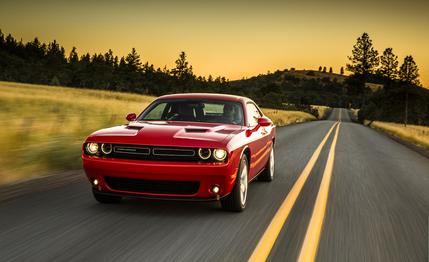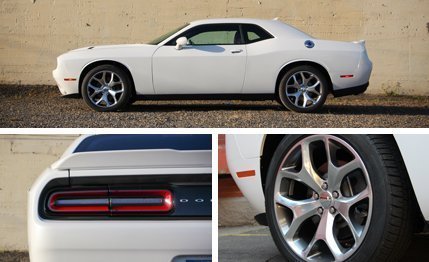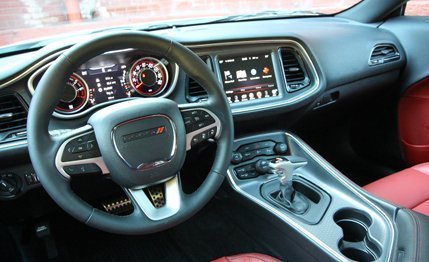 First Drive Review
First Drive Review
From the “how ’bout that?” department comes this interesting fact: Dodge Challenger retail sales have doubled since its early days on the market in 2009, according to Dodge. This is in spite of the car receiving basically zero visual updates to its 1970-inspired styling and packing a cut-buck interior dating back to the dark days of DaimlerChrysler. Furthermore, roughly half of those Challengers have been equipped with—bless their hearts—a V-6.
Admittedly, it’s tough for enthusiasts to take V-6–powered pony cars seriously. But with four-cylinder Mustangs about to roam the streets again—and as a serious performance option—we took particular interest in the 2015 Dodge Challenger V-6 at the recent launch of the newly revamped 2015 Challenger line in Portland, Oregon. Would it finally be a viable option for muscle fans on a budget, or would it continue in the grand tradition of V-6 Challengers past and offer far more show than go?
The six-cylinder Challenger has come a long way since it arrived in ’09 powered by a wheezy, 250-hp 3.5-liter V-6 mated to a slushy five-speed automatic. Our testing showed it capable of an only so-so 7.5-second 0-to-60-mph time and a sad 0.78 g on the skidpad, with the handling punctuated by tire-squealing understeer that bordered on the extreme. In 2011, Chrysler’s Pentastar 3.6-liter V-6 producing 305 hp and 268 lb-ft of torque took over, albeit with the same antiquated transmission. Thus equipped, the six-hole Challenger chopped more than a second off its 0–60 time. Meanwhile, an optional Super Sport Group with revised brakes, stiffened suspension bits, and 20-inch wheels did yeoman’s work in cleaning up the handling and dramatically shortening braking performance. In other words, there was hope.

For 2015, the 3.6-liter Pentastar carries over largely unchanged but has finally been paired to Chrysler’s excellent ZF-designed eight-speed automatic with the now-familiar T-handle shifter and manual shift control. (There are no steering-wheel shift paddles, however.) We expect the new transmission to save a few tenths during the sprint to 60 mph, and it will also improve the fuel economy from 18 mpg city/27 highway to 19/30.
Also helping this Challenger’s cause is that the Super Track Pak option—the spiritual successor to the Super Sport Group package—is now available with the V-6. It adds matte-black 20-inch wheels, stickier Goodyear summer tires, a more buttoned-down suspension, revised steering, upgraded brakes, and Dodge Performance Pages. We hustled around Portland International Raceway in an SXT model with the Pak, sharing the track with four other drivers in 485-hp Challenger SRT 392 and R/T Scat Pack models. While they used their mighty Hemis to pull away on the straights, we were easily able to hang with them in the twistier sections. The reeling-in came courtesy of the confidence-inspiring steering and the effect of some 300 fewer pounds to haul around, according to Chrysler, most of it coming off the front axle. There isn’t quite enough power to steer with the rear as easily as in the V-8 cars, but with the car in Sport mode, you can at least take advantage of what grunt is there as the eight-speed keeps the engine in the meat of the power band.
The real dynamic weakness is a brake pedal that lacks bite despite having two-piston front calipers clamping down on 13.6-inch rotors versus the single-piston, 12.6-inch setup on the non-Paked V-6. That said, the particular car we drove had been flogged around the hot PIR tarmac dozens of times before we slid behind the wheel; a fresher example might have performed better, so we’ll reserve final judgment until we get a chance to test the car on our terms.

The V-6 Challenger is available in SXT and SXT Plus guise. We spent a couple of hours trolling the roads around Portland in the latter to get acquainted—or rather, reacquainted—with the softer side of the Challenger. The experience reminded us that the Challenger essentially remains a Charger sedan with a few inches cut from its middle. Around town, the V-6 is quiet and subdued, and the overall feeling is one of massiveness and maturity. This particular model doesn’t encourage displays of raw testosterone, as do the brutal Challenger Hellcat or the naturally aspirated Hemi models. Charge hard into a tight corner and you’ll watch the wide, flat hood dip down toward the outside at turn-in, although the 20-inch wheels and wide tires of our test car (18s are standard with the V-6) meant that it never felt short on grip once it took a set. The big blind spots and formidable width are somewhat less problematic than before, too, thanks to newly available blind-spot and cross-path monitoring systems.
We also really like the visual update that all Challengers received for 2015. The refresh sees the retro design tick up a year, with many details inspired by the 1971 Challenger. Among the standout features are the brooding LED halo-ring headlamps with integrated turn signals, the split-port grille inserts, smoother front and rear fascias, and double-racetrack all-LED taillamps. A family of gorgeous new wheels has also come online this year, including those on the SXT Plus we drove.
If the exterior update is pleasing, what has happened inside is a revelation. The all-new dashboard also traces its stylistic roots to the 1971 model; the new car’s interior designers reportedly scavenged swap meets until they found a ’71 Challenger dash and set it up inside the studio during the redesign process. The primary gauges are conical dials with hidden needles and a classic muscle-car-style font, although they bracket a fully modern and high-resolution seven-inch TFT screen with virtual gear-selection, fuel, and temperature displays, as well as selectable trip- and vehicle-related information.
Particularly when ordered with the Super Track Pak features, the V-6 Challenger offers more go than ever before. Yes, it’s still more about the show, and it’s not as fun as the V-8 cars, but it’s no longer best left to rental fleets. How ’bout that?